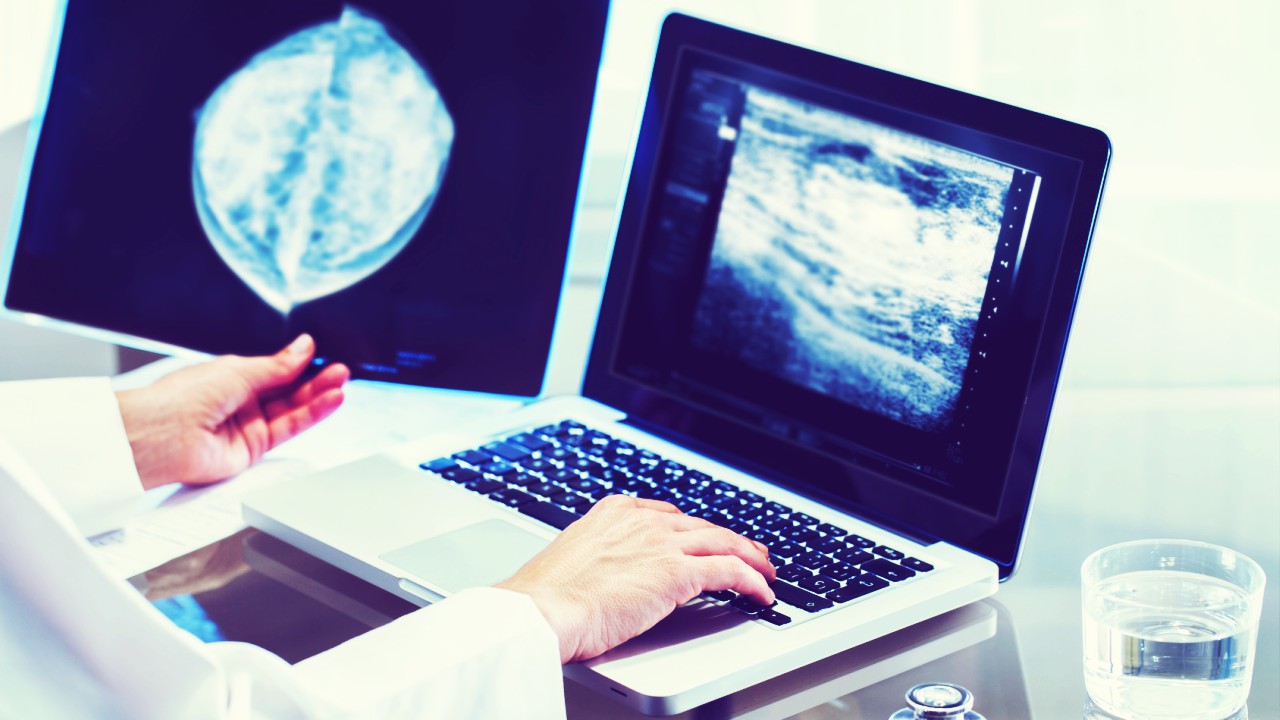Since the U.S. Preventive Services Task Force’s early detection against breast cancer recommendations came out, everyone is debating how often women should get mammograms.
Hi, this is Todd Hartley for EmpowHER, and with one in eight women developing breast cancer in their lifetime the real difficulty is identifying who is at risk. So quickly, let me tell you about the U.S. Preventive Services Task Force’s early detection against breast cancer recommendations.
Now the Task Force said, “Women in their 40s do not need routine mammograms unless a predisposition exists. Women should get a mammogram every two years starting at age 50 unless (well, you guessed it) a predisposition exists. And self-breast exams – they do more harm than good for women without a predisposition.”
But if one in eight women develop breast cancer in their lifetime and if women under the age of 50 years aren’t getting mammograms, what’s available to protect the women we love? Because necessity is still the mother of invention, I’d like to introduce you to John Stroh. John is the CEO of NeoMatrix and they are the creators of the HALO® Breast Pap Test.
Now this test is a non-invasive, FDA-approved, five-minute test that gives doctors and patients well, a new method to monitor a woman’s breast cancer risk. John, tell me about the HALO® Breast Pap Test. I know it’s not a diagnostic test; instead it’s a risk assessment test. Can you explain the difference?
John Stroh:
Sure. A diagnostic test is looking for the presence or absence of disease. What we are looking for is women who are at high risk of developing breast cancer. So, we are screening for risk versus screening for disease. What we are looking for is a condition called atypia or atypical ductal hyperplasia, and what that is, is an early indication of a predisposition towards cancer.
So, if a woman has atypia she has a 4-500% increased risk of developing breast cancer over her lifetime. So, by identifying these women at high risk, you can put them into the health care system. You can do a full risk assessment in order to ascertain really, what their entire risk profile is; that’s typically done with what’s called a Gail risk model.
Some cases, things as simple as lifestyle changes, stopping smoking, losing weight, better eating habits, cutting back on drinking, can actually reverse atypia and help to inhibit the cancer.
In the other scale there are drugs called chemoprevention drugs that are used to inhibit the cancer in women that have known biomarker risk or other risk factors, and more frequent and more specific monitoring, seeing that patient maybe every six months, doing a HALO® or a mammogram every six months, and in many cases, it may entail a yearly MRI for women who are at a 20% plus lifetime risk.
So again, we are looking to identify women at high risk of developing breast cancer versus a diagnostic test looking for women that actually have cancer.
Todd Hartley:
Okay, so if I understand this correctly, the HALO® doesn’t replace mammograms, but it’s a complement to mammograms, correct?
John Stroh:
Yeah, very much so. A mammogram is looking for a lump and in most cases, if a lump is showing up on a mammogram that lump has been growing eight to ten years. What we are looking for are early cellular changes and before it is turned into a cancer or a lump. So by looking at those early changes, we can identify those women at higher risk of developing breast cancer. So it really is the difference of trying to find the cancer or the risk of cancer before it turns into a lump.
Todd Hartley:
So HALO® looks for abnormal cells years before they may turn into something that could be a problem. What’s the age range that the HALO® test could be effective for women?
John Stroh:
Well, we recommend 25 to 55. There’s a couple of reasons why we look at that demographic as our ideal target audience. One, 35 to 55, breast cancer is the number one killer of women. Second of all, women under 40 who are not getting mammograms and if these new guidelines are enacted that would be under 50, so women in that age group are not getting mammograms in most cases. Maybe the only defense they have for finding their risk of breast cancer is clinical breast exam that’s done once a year when she goes in and get her cervical Pap.
So there’s very limited tools that women at the, under 40 specifically, have in their fight against breast cancer, so, and another factor as well is that women under 40 typically have denser breasts, which makes it even more difficult to see any type of abnormalities on a mammogram even if they were getting a mammogram.
So, we are particularly effective for younger women because breast density does not impact the ability to test with HALO® and one of the risks of getting breast cancer in earlier age is typically more deadly as well. So that’s why we target the younger women.
The HALO® can be done on women that are post-menopausal, although the mammogram is a better test as women age because as their breasts become less dense its easier to pick up abnormalities on a mammogram. So we absolutely look at this as a complementary test to the mammogram.
Todd Hartley:
That sounds wonderful. Okay, let’s talk about the HALO® Breast Pap Test and how it’s performed. What should women expect, John?
John Stroh:
Absolutely. The way the test is performed, in most cases it’s done in the woman’s primary care physician’s office. So her OB/GYN in most cases or it may be her general practitioner, that’s who she goes to for her yearly exam. The HALO® itself is about the size of a laser printer and there are two cups that go over the end of the breasts. They are adjustable to the size of the woman’s breast, so essentially one size fits all. That way the physician doesn’t have to keep a lot of stock there in their office for multiple size cups, and what happens is there is a water reservoir in the middle of the HALO® that warms up when the machine, when the testing starts, and that water goes to the cups that is being held over the breast and it warms breast.
There is a compression at the end of the breast to help elicit the fluid and then suction, which actually draws the fluid out. So the entire procedure is five minutes. It’s fully automated, meaning there’s just one button to push, and an alarm goes off at the end of the five minutes alerting the practitioner that the test is completed. It’s typically done by a medical assistant or a nurse in the office, so it doesn’t take the doctor away from his/her practice, which is particularly important in a very busy practice where they may be seeing patients every 10 to 12 minutes.
At the end of the five minutes, the practitioner will check to see if any fluid has been elicited, it will be swapped, put into a non-gynecological cytology vile and then sent to the local lab that is doing the cervical paps for that particular office. So the results are usually back to the patient, or back to the doctor, with anywhere from 24 hours to 36 hours is the normal time frame.
Todd Hartley:
Now this five-minute test, during it, how many women produce fluid and what does it mean if they do not produce any fluid? Give us an idea.
John Stroh:
Well, the range of women that produce fluid is somewhere between 40 to 60%. In our clinical study of 500 patients it was about 50% and if a woman does not produce fluid, that’s actually positive. That infers a normal risk. If a woman produces fluid and does not have atypia, then that infers approximately a double risk of developing breast cancer over their lifetime.
If a woman produces fluid and does have atypical cells and again, there’s a variation or degree or grading, if you will, of different types of atypia, from hyperplasia, which is pre-atypia, to a high-grade atypia, which is essentially the step before cancer, that infers a 4 to 500% increased risk of developing breast cancer. So, again, no fluid is normal risk. Fluid with atypia is 4 to 500% increased risk of developing breast cancer over their lifetime.
Todd Hartley:
All right. So let me see if I understand this – HALO® is a risk assessment test. It is not a replacement to a mammogram, but instead it is complementary and it looks for abnormal cells years before they may turn into a problem. What other question didn’t I ask you that would be beneficial to women while I got you here John?
John Stroh:
Well I think, in the 1940s when Dr. Papanicolaou invented the cervical pap he wrote quite extensively on the need to look at the epithelial cells in the lining of a woman’s milk ducts for these precancerous predispositions and again, using the cervical pap as an analogy, when the cervical pap was first introduced in the late 30s, cervical cancer was one of the number one killers of women and throughout the years, as a result of the cervical pap, cervical cancer is now a disease that kills about 3,200 women a year.
So, the cervical pap has had dramatic effect on the decline in death rate of cervical cancer. We too, like the cervical pap, are looking for abnormal cellular changes. The problem in finding or getting to the nipple aspirate fluid has been the ability to collect the nipple aspirate fluid. Unlike the cervix, which is very accessible to the OB/GYN, the fluid in the milk duct is not. So, historically it has been gathered in two ways. One is what’s called sartorius method, which is warm towel’s compression and that takes about a half hour, in some cases even longer. So it’s not really conducive to an office setting where they are seeing a lot of patients throughout the day.
The other way of eliciting the fluid is what’s called fine-needle operation and obviously, a needle going into the nipple to draw out the fluid is very invasive, very painful. The third way was a product that came out a few years ago called ductal lavage, or First Cyte, and that had the same theory as fine needle aspiration but that was putting a needle into the cannula, into the nipple, lavaging the milk ducts and then taking the fluid and the epithelial cells and analyzing it cytologically as we do as well for those abnormal changes – the atypia.
What we have developed with the HALO® is a better collection device. By having a fully automated, five-minute, non-invasive test we have really developed a way to get to the nipple aspirate fluid in a completely non-invasive way. In a 500 patient trial, we asked the women to rate the pain of the HALO® procedure, and what we came back was a three to four on a scale of 1 to 10.
A mammogram was rated 8, so it’s a little bit less than half with most women, the pain of a mammogram. So very, very well tolerated. Some women who are particularly sensitive may find it more difficult or more uncomfortable, but in general, women look at it and we’ve heard the analogy, you know, a warm, comfortable sensation to breasts, the same as, very similar to this sensation of breastfeeding. But in general, very, very well tolerated, particularly in light of other procedures like the mammogram.
Todd Hartley:
EmpowHER was created to help women make sense of the confusion and the evolving science of health and that’s why we wanted to check in with John Stroh. John is the CEO of NeoMatrix – the creators of the HALO® Breast Pap Test, as we have been discussing, and if you’d like to find out more information, go to NeoMatrix.com or, just click the ‘ASK’ button right here on EmpowHER and one of our experts will get back to you within 24 hours.
John Stroh, thank you so much for helping us educate women.
John Stroh:
My pleasure Todd, I also want to thank EmpowHER for all the work that you are doing and the organization is doing. We also are firm believers in giving women the tools they need to better manage their health, to better manage their breast health and HALO® is one of those tools that can help a woman gain more control over their breast health. So thanks again.
Todd Hartley:
It definitely shows John. Thank you so much for joining us on EmpowHER.
John Stroh:
Thank you Todd.





























